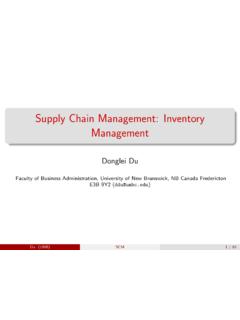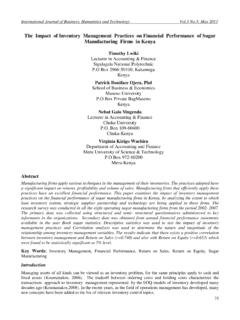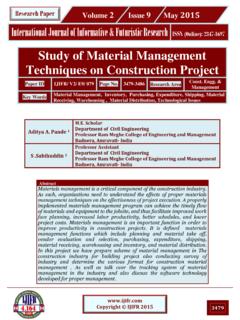Transcription of The EOQ Formula - Books in the Mathematical Sciences
1 The EOQ Inventory FormulaJames M. CargalMathematics DepartmentTroy University Montgomery CampusA basic problem for businesses and manufacturers is, when ordering supplies, to determinewhat quantity of a given item to order. A great deal of literature has dealt with this problem(unfortunately many of the best Books on the subject are out of print). Many formulas andalgorithms have been created. Of these the simplest Formula is the most used: The EOQ (economicorder quantity ) or Lot Size Formula . The EOQ Formula has been independently discovered manytimes in the last eighty years. We will see that the EOQ Formula is simplistic and uses severalunrealistic assumptions. This raises the question, which we will address: given that it is sounrealistic, why does the Formula work so well? Indeed, despite the many more sophisticatedformulas and algorithms available, even large corporations use the EOQ Formula .
2 In general, largecorporations that use the EOQ Formula do not want the public or competitors to know they usesomething so unsophisticated. Hence you might wonder how I can state that large corporations douse the EOQ Formula . Let s just say that I have good sources of information that I feel can be Variables of the EOQ ProblemLet us assume that we are interested in optimal inventory policies for widgets. The EOQformula uses four variables. They are:D: The demand for widgets in quantity per unit time. Demand can be thought of as :The order quantity . This is the variable we want to optimize. All the other variablesare fixed :The order cost. This is the flat fee charged for making any order and is independentof :Holding costs per widget per unit time. If we store x widgets for one unit of time,it costs us EOQ problem can be summarized as determining the order quantity Q, that balances theorder cost C and the holding costs h to minimize total costs.
3 The greater Q is, the less we will spendon orders, since we order less often. On the other hand, the greater Q is the more we spend oninventory. Note that the price of widgets is a variables that does not interest us. This is becausewe plan to meet the demand for widgets. Hence the value of Q has nothing to do with this quantity . If we put the price of widgets into our problem formulation, when we finally have finally solved theoptimal value for Q, it will not involve this term. The EOQ Inventory Formula by J. M. CargalFigure 1 The EOQ ProcessTPCQhQDCQhD 222Tu CDQQh2 The Assumptions of the EOQ ModelThe underlying assumptions of the EOQ problem can be represented by Figure 1. The ideais that orders for widgets arrive instantly and all at once. Secondly, the demand for widgets isperfectly steady. Note that it is relatively easy to modify these assumptions; Hadley and Whitin[1963] cover many such cases.
4 Despite the fact that many more elaborate models have beenconstructed for inventory problem the EOQ model is by far the most used. An Incorrect SolutionSolving for the EOQ, that is the quantity that minimizes total costs, requires that weformulate what the costs are. The order period is the block of time between two consecutive orders. The length of the order period, which we will denote by P, is Q/D. For example, if the orderquantity is 20 widgets and the rate of demand is five widgets per day, then the order period is 20/5,or four days. Let Tp be the total costs per order period. By definition, the order cost per order periodwill be C. During the order period the inventory will go steadily from Q, the order amount, to zero. Hence the average inventory is Q/2 and the inventory costs per period is the average cost, Q/2, timesthe length of the period, Q/D.
5 Hence the total cost per period is:If we take the derivative of Tp with respect to Q and set it to zero, we get Q = 0. The problem issolved by the device of not ordering anything. This indeed minimizes the inventory costs but at thesmall inconvenience of not meeting demand and therefore going out of business. This is what manypeople, perhaps most people do, when trying to solve for the EOQ the first Classic EOQ DerivationThe first step to solving the EOQ problem is to correctly state the inventory costs Formula . This can be done by taking the cost per period Tp and dividing by the length of the period, Q/D, toget the total cost per unit time, Tu:2 The EOQ Inventory Formula by J. M. CargalQhQTCDu220 QThCDhThuu 22220 ThQThkuu222 Tu* 2 CDhQ* 2 CDhIn this Formula the order cost per unit time is CD/Q and Qh/2 is the average inventory cost per unittime. If we take the derivative of Tu with respect to Q and set that equal to 0, we can solve for theeconomic order quantity (where the exponent * implies that this is the optimal order quantity ):If we plug Q* into the Formula for Tu, we get the optimal cost, per unit time:The Algebraic SolutionIt never hurts to solve a problem in two different ways.
6 Usually each solution technique willyield its own insights. In any case, getting the same answer by two different methods, is a great wayto verify the result. If we multiply the Formula for Tu on both sides by Q, we get, after a littlerearranging, a quadratic equation in Q: Next we divide through by h/2 to change our leading coefficient to 1. Completing the square, weget: Note that this equation has two variables. Tu is a function of Q (and could well be written as Tu(Q)). Hence we have a curve in the Cartesian plane with axes labeled Q and Tu. We want the value of Qthat minimizes Tu. Notice that the term is a constant. Writing that constant as k, and2 CDhrearranging the equation, we get: 3 The EOQ Inventory Formula by J. M. Cargal0 200 400 600 800 1000 1200 1400 1600 Total Cost161116212631364146515661667176 Order QuantityMinFigure 2 Total Cost as a Function of Order QuantityQ.
7 * 23050622 36If we set the quadratic term to zero, then . Any change in the quadratic term from zeroThku increases the size of Tu. Hence the optimal size of Tu is which just happens to be hkwhich is the value we found earlier. The quadratic term is zero if and only if . 2 CDhQThu This gives us the identity . Qh Tu** An ExampleIt is useful at this point to consider a numerical example. The demand for klabitz s is 50 perweek. The order cost is $30 (regardless of the size of the order), and the holding cost is $6 perklabitz per week. Plugging these figures into the EOQ Formula we get:This brings up a little mentioned drawback of the EOQ Formula . The EOQ Formula is not an integerformula. It would be more appropriate if we ordered klabitz s by the gallon. Most of the time, thenearest integer will be the optimal integer amount. In this case, the total inventory cost Tu is $ week when we order 22 klabitz s.
8 If instead, we order 23 klabitz s the cost is $ 4 The EOQ Inventory Formula by J. M. Cargal0 200 400 600 800 1000 1200 1400 1600 Order CostHolding Cost161116212631364146515661667176 Order QuantityMinFigure 3 Order and Holding CostsdTdQCDQ2232 dTdQhCDhCD22224* A graph of this problem is illuminating: Figure 2. Because the graph is so flat at the optimalpoint, there is very little penalty if we order a slightly sub-optimal quantity . We can betterunderstand the graph if we view the combined graphs of the order costs and the holding costs givenin Figure 3. The basic shapes of all three graphs (total costs, order costs, holding costs) are alwaysthe same. The graph of order costs is a hyperbola; the graph of holding costs is linear; and as aresult the graph of the total costs (Tu) is convex. This can also be seen in that the function isdTdQuincreasing and the functionis positive every where.
9 If we plug the optimal quantity , Q*, into this last Formula we get:5 The EOQ Inventory Formula by J. M. CargalOrdinarily this last quantity is very small, which indicates that the total cost of inventory Tu changesvery slowly with Q (in the optimal region). Hence the assumptions of the EOQ model do not haveto be accurate because the problem usually is tolerant of you study closely the graphs in Figure 3, it may seem clear to you that their sum, Tu, reaches a minimum precisely where the two graphs intersect; that is at the point where order costsand holding costs are equal. The gives us the equality . Solving that equality is the easiestQhCDQ2 way to derive the EOQ Formula . Why Use the EOQ Formula At All?A problem that occurs in applied mathematics more than pure is that we hang onto formulasand techniques that have been made (mostly) obsolete by technology. Try to think what it was liketo solve a problem like the one here forty years ago.
10 The simple operation of division was eitherdone by hand, or by use of logarithms out of a table, or less exactly by using a slide rule. It was notpractical to simply calculate the total cost of inventory for a large set of order quantities and tocompare answers. The EOQ Formula simplified the problem to a minimal number of calculations. However, now it is quite simple to calculate total costs of inventory for hundreds of order quantities,and this can be done from scratch in less time than it use to take to employ the EOQ Formula . Wecan do it with a spreadsheet. The spreadsheet in Figure 4, takes the problem from the previous example, and computesfor a large variety of quantities the order costs, holding costs, and total costs. It took about 15minutes to set this spreadsheet up, and most of that time was spent on formatting (for exampleputting in lines). The formulas for order costs and holding costs were inserted to calculate therespective entries for the order quantity of one.






